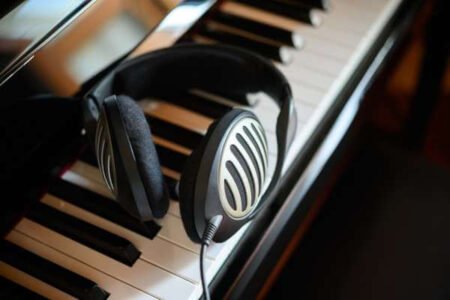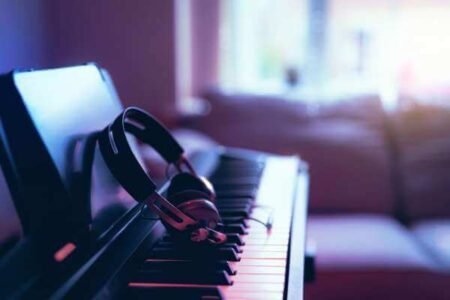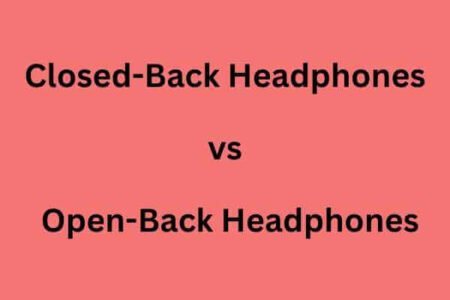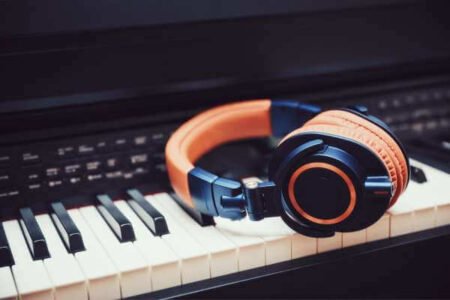When it comes to playing the piano, whether you’re a professional musician or just starting, having the right pair of headphones can make all the difference. The quest for high-quality sound is paramount, as it allows you to hear every nuance of your piano sounds, from the softest pianissimo to the most thunderous fortissimo. In this article, we’ll explore the best headphones for piano players, taking into account various factors such as sound quality, comfort, and design.
Is it better to play the piano with headphones?

There are pros and cons to playing the piano with headphones versus without. Here’s a balanced perspective:
Advantages of Using Headphones:
Noise isolation
Headphones block out external noise and distractions, allowing you to focus solely on your playing and the music.
Private practice
You can practice at any time without disturbing others, especially in shared spaces or late at night.
Critical listening
High-quality headphones create an immersive and detailed listening experience. This allows you to hear nuances and subtleties in your piano playing that you may otherwise miss without headphones.
Recording reference
When recording piano, headphones allow you to hear a click track or guide track.
Disadvantages of Using Headphones:
Unnatural sound
The acoustics of the piano are meant to be heard in an open room, and headphones can make the sound feel unnaturally close or confined.
Lack of resonance
You miss out on feeling the full resonance and vibrations produced by the piano’s soundboard.
Potential ear fatigue
Extended headphone use can lead to ear fatigue or headaches for some people.
Disconnected feel
Some pianists feel more disconnected from the instrument when using headphones.
Ultimately, it comes down to personal preference and the situation. Headphones are very useful for focused practice, late nights, recording, and noise isolation. But for performances or simply enjoying the full resonance of the piano, playing without headphones is preferred by many pianists. A balanced approach utilizing both methods can be ideal.
How to choose headphones for a digital piano?

When choosing headphones for a digital piano, there are several important factors to consider:
Sound Quality
Look for headphones that offer accurate sound reproduction and a balanced frequency response. This will allow you to hear the true sound of the piano and all its nuances. Over-emphasized bass or treble can distort the piano’s natural sound.
Open-Back vs. Closed-Back
Open-back headphones provide a more natural and spacious sound, allowing air to pass through the earcups. However, they don’t isolate noise well. Closed-back headphones offer better noise isolation, which can be beneficial for practicing in noisy environments or late at night.
Impedance
Digital pianos typically have low-impedance headphone outputs. Opt for headphones with an impedance rating between 32-100 ohms to ensure they can be driven properly by the piano’s headphone jack.
Comfort
You may need to wear headphones for lengthy practice sessions on the piano. For that reason, choose a pair with well-padded earcups that feel comfortable as well as an adjustable, lightweight design.
Wired or Wireless
Wired headphones offer a direct connection to the piano with no latency or interference issues. However, wireless Bluetooth headphones provide freedom of movement but may require an adapter or transmitter for the digital piano.
Durability
Look for headphones with sturdy build quality and replaceable cables (if applicable) to withstand the rigors of frequent use and transportation.
Budget
Headphones for digital pianos can range from affordable options around $50 to high-end models costing several hundred dollars. Determine your budget and prioritize the features most important to you.
What Headphone Type to Look For?
The headphone market offers a wide array of designs, such as earbuds that fit snugly within the ear canal, on-ear models that rest on the outer ear, and in-ear variants that are inserted into the ear. However, when it comes to pairing headphones with a digital piano, the ideal choice lies with over-ear headphones. These encompass the entire ear within cushioned earcups, providing the most suitable form factor for extended listening sessions at the piano. While in-ear and on-ear designs may suffice in certain scenarios, over-ear headphones excel in delivering the optimal audio experience for pianists, making them the preferred option for this application.
Types of over-ear headphones

1. Closed-Back Headphones: The Sound of Silence
Closed-back headphones are a type of over-ear or on-ear headphones with a design that fully encloses the back of the ear cups. This design serves to isolate the listener from external ambient noise and minimize sound leakage from the earpieces, making them ideal for environments where you do not want to be disturbed by outside sounds or disturb others with your music.
They tend to have more bass than open-back headphones due to the sealed rear air volume, which can emphasize lower frequencies. This makes closed-back headphones versatile for various settings, including commutes, outdoor strolls, and working in shared spaces. They are also beneficial for recording in studios where sound isolation is crucial
Best Closed-Back Headphones for Piano
For those who practice the piano in a noisy environment or have family members to consider, closed-back headphones like the Beyerdynamic DT series or the Audio-Technica ATH-M line are the best choice. With their closed-back design, they provide excellent noise cancellation, keeping external noise at bay and preventing sound leakage. This means you can focus on your piano practice for long periods without disturbing others.
- LIMITED EDITION: all black (no gray color at earpads etc…), 3m STRAIGHT cable
- Except the cable and color it’s identical to “normal” DT990 PRO 250ohm
- Durable construction with replaceable parts
- Excellent sound reproduction
- Comfortable fit due to rugged, adjustable, padded headband construction and soft velour ear pads
- Critically acclaimed sonic performance praised by top audio engineers and pro audio reviewers
- Proprietary 45 millimeter large aperture drivers with rare earth magnets and copper clad aluminum wire voice coils
- Exceptional clarity throughout an extended frequency range, with deep, accurate bass response
- Circumaural design contours around the ears for excellent sound isolation in loud environments
- 90 degree swiveling earcups for easy, one ear monitoring, and professional grade earpad and headband material delivers more durability and comfort
2. Open-Back Headphones: Natural and Airy
Open-back headphones are designed with the back of the ear cups open, allowing air and sound to pass freely through. This design contributes to a more natural and expansive soundstage, making the audio feel as if it’s coming from around you rather than from inside your head. It can create a sense of space and ambiance that is similar to listening to speakers in a room.
However, because of their open nature, they do not isolate sound well. This means they’re not ideal for noisy environments as they allow background noise to seep in and also let the music out, which can be heard by others nearby. They’re best suited for quiet environments where you can enjoy their natural sound without disturbance, such as at home or in a studio setting
Best Open-Back Headphones for Piano
Conversely, open-back headphones such as the AKG K series or the Sennheiser HD models offer a more natural sound. They are designed to allow some ambient noise to blend with the music, creating an immersive sound experience that mimics the acoustics of a concert hall, like the Sydney Opera House or the Royal Albert Hall. This open-back design also typically results in a wider frequency response, providing a crystal-clear sound across the spectrum.
- 55 ohms impedance, plug-in cable
- Self-adjusting headband for optimum fit
- Single cable for ease of use
- Semi-open, circumaural design
Digital Piano Headphones: Tailored for the Keys
Specifically designed digital piano headphones often come with features that cater to the needs of digital piano players. Look for models with mm drivers that deliver accurate sound and an adjustable headband for a comfortable fit during those long practice sessions. The headphone output on your digital piano should match the headphone jack of your chosen headphones to ensure compatibility and the best sound quality.
Finding Your Perfect Match
Ultimately, the right headphones for you will depend on your personal preference and the specifics of your digital piano setup. Whether you opt for wireless headphones for freedom of movement, studio headphones with a neutral sound for recording, or over-ear headphones for a comfortable fit, remember that good sound quality is key. Consider the build quality and price point to ensure you get the best value for your investment.
FAQ

Why do people wear headphones when playing piano?
Pianists widely use headphones for several reasons: they provide noise isolation, allowing focused practice without disturbing others; they offer an immersive, critical listening experience to hear every nuance and detail of one’s playing; they enable clear monitoring of recording click tracks, backing tracks, or online lesson accompaniments; they amplify the sound from digital pianos when external speakers are impractical; and they facilitate private experimentation with different sound effects and virtual instruments. By creating a personalized audio environment, headphones enhance the practice routine, enabling pianists to critically evaluate their performance, follow instructional materials precisely, and explore their instrument’s full range of tones and dynamics without external distractions or noise pollution. The focused, isolated atmosphere provided by headphones is invaluable for serious piano students and professionals alike.
Can I connect headphones to piano?
Many digital pianos feature an auxiliary input, typically a 1/8″ (3.5mm) jack labeled “Audio In,” “Aux In,” or “Auxiliary In.” If your keyboard has a port like this, you’re all set – you simply need to obtain a cable that can transmit the audio signal from the headphone output on your audio device to this auxiliary input on your digital piano. By connecting the two with a compatible cable, you’ll be able to hear the audio from your device played through the piano’s built-in speakers or headphone output.
What headphone jack for piano?
When it comes to connecting headphones to a piano, there are a few common options for the headphone jack:
- 1/4″ (6.35mm) Stereo Jack Most digital pianos and keyboard workstations have a 1/4″ stereo headphone output jack. This is the standard-size jack used for headphones and audio equipment. Make sure your headphones have a 1/4″ stereo plug or use a 1/4″ to 1/8″ (3.5mm) adapter.
- 1/8″ (3.5mm) Stereo Mini Jack Some portable keyboards and more affordable digital pianos may have a 1/8″ (3.5mm) mini stereo headphone jack, which is the same size commonly found on phones and audio devices. Standard headphones with 3.5mm plugs can plug directly into these jacks.
- Dual 1/4″ Jacks Higher-end digital pianos sometimes have two separate 1/4″ jacks – one for left audio output and one for right. This allows the connection of two sets of headphones or speakers. Requires headphones with a 1/4″ TRS plug or adapter cables.
- USB Audio Interface Many advanced digital pianos don’t have dedicated headphone jacks. Instead, you connect headphones to the piano’s audio output via a USB audio interface, which has headphone jacks built-in.
When purchasing headphones for piano use, make sure they have the appropriate sized plug (1/4″ or 1/8″) or get an adapter to match your piano’s headphone jack. Some headphones even come with both-size plugs included.
Conclusion
Whether you’re a professional pianist, a music student, or simply someone who enjoys playing the piano at home, having a great pair of headphones can significantly enhance your musical experience. With so many options available on the market, it’s crucial to choose a pair that not only delivers exceptional sound quality but also provides comfort and durability.
In this article, we’ve explored some of the best headphones for piano, taking into account factors such as sound accuracy, noise isolation, and comfort. From the precise and detailed sound of open-back headphones like the Sennheiser HD to the immersive and isolating experience of closed-back models like the Beyerdynamic DT, there’s an option to suit every pianist’s needs and preferences.
Remember, when it comes to piano performance and practice, investing in a high-quality pair of headphones can make a world of difference. Not only will you be able to hear every nuance and detail of your playing, but you’ll also be able to practice without disturbing others or being distracted by external noise.
Ultimately, the best headphones for piano are the ones that allow you to fully immerse yourself in the music, enabling you to refine your technique, interpret compositions with precision, and truly appreciate the beauty of this timeless instrument.



